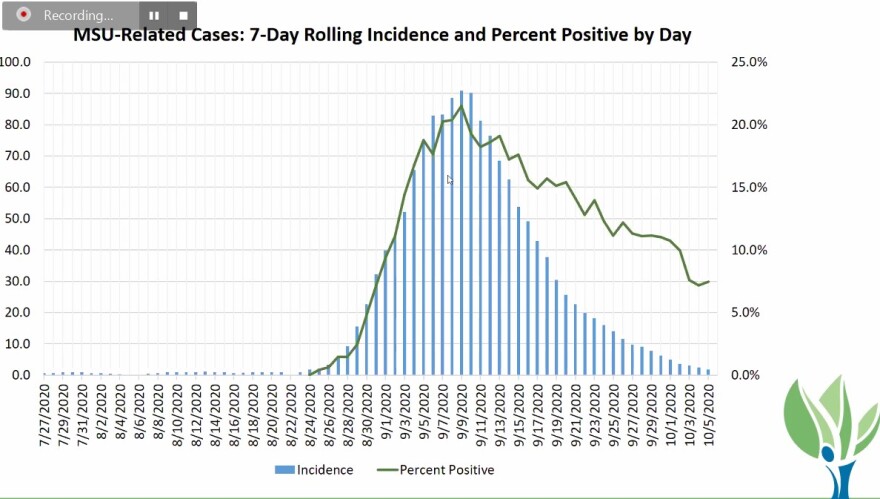At first, Linda Vail didn’t buy it.

As recently as last week, the Ingham County public health officer was skeptical of data that showed Michigan State University cases were rapidly declining.
It didn’t seem possible that the university with the biggest COVID-19 outbreak in the state so far (1,486 cases as of October 7, according to the school’s online dashboard) could see such a swift decline: a more than 50% drop from the week of September 7 to the week of September 14. During this same period, the number of tests being performed on campus initially increased, but then dropped suddenly the next week by more than 50%.
“Given what we know about this disease, and how long it takes people to transmit it to others and incubation periods…[it’s] all leading to this notion that there have been a lot of choices to just not go get tested,” Vail said at a September 29 press conference. (MSU President Samuel Stanley sent out a community letter the same day, imploring students and staff to get tested and cooperate with contact tracers.)
But now, with another week’s worth of data showing a more gradual downturn and a decreasing percentage of positive test results, Vail is more optimistic that this downturn may be real.
“So when you put those two together, with incidents [of new cases] on a rolling [7-day] average, as well as percent positivity on a rolling average, we do now see this trend coming down, which would indicate cases should be going down,” Vail said on October 6. “So a combination of probably some lack of testing, as well as just plain old hard work getting cases down,have brought this really huge surge in cases down fairly rapidly.”

The key there is the rolling, 7-day average: by averaging those numbers out, you can see past daily spikes or drops in cases and get a better picture of the longer term trend.
On one hand, Vail thinks there is still some lack of willingness to get tested, based on social media posts and the health department’s conversations with students in group houses that have been put under mandatory quarantines, she says.
“[The decline in cases] probably looks a little more accelerated than it might have if there had not also been a drop in testing right at the beginning, when we knew case counts were really high.”
But the decline in the percentage of positive MSU tests is encouraging.
“So even if fewer people get tested, if the transmission rates are high, you would expect to see a high percent positivity. In other words, of those going to get tested, a lot are positive,” Vail says. “So when you see a lower percent positivity - and we did see that percent positivity start to nicely decline - that does also indicate that we truly are just having a decline in cases. So it's a little bit of a combination of both.”
A spokesperson for Michigan State University said no one from the school's COVID-19 health team was immediately available to comment on the decline in cases.
Public health measures may be paying off
Grand Valley State University has seen a similar trend: an initial surge at the start of the academic year, followed by a stay-at-home-order for students and, eventually, a decline in cases and an
Unlike GVSU’s hybrid learning model, Michigan State University made a last-minute switch to primarily remote classes. But that didn’t prevent what the school called an “alarming surge” in outbreaks off campus, prompting the Ingham County Health Department to issue mandatory quarantine orders to 39 group houses and issue a “strong” recommendation that all students quarantine until September 25.
The week after that quarantine recommendation was lifted, the health department reported only 27 MSU-related COVID-19 cases, the lowest in more than a month. That’s down from a record 632 cases the week of September 7.
Meanwhile, an Ingham County public health order continues to limit restaurant capacity to 50% or 125 people, whichever is less. While Vail says they’ve been having “a number of issues with the bars and restaurants in East Lansing,” things appear to have been improving there as well.
“I will say also that our environmental health team was out in East Lansing over this weekend, late in the evening. And things were much, much improved... I think what we saw this weekend was the result of some conversations [with local restaurant associations] and some reminders.”
But those improvements haven’t fully prevented the MSU outbreaks from spreading into the larger community, Vail says. Non-MSU cases in East Lansing’s 48823 zip code have climbed from 44 in August, to 98 in September.
“We are seeing that increase now in the surrounding community,” Vail says. “And that seems to be holding true for October, where already the number of referrals and cases are exceeding those that I saw in August as well.”
Want to support reporting like this? Consider making a gift to Michigan Radio today.







